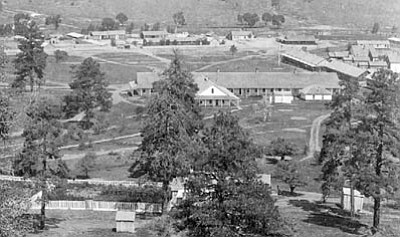By Al Bates
Al Bates, local historian, has written articles for Days Past (1999 and 2000) about the history of Fort Whipple. The following is the first of a two-part condensed and edited rendering of those articles by Kathy Krause.
Fort Whipple was a U.S. Army post located originally in Val de Chino (Chino Valley) in December of 1863, moving in late May of 1864 to the banks of Granite Creek, on the site of the current Bob Stump Veterans' Administation (VA) Medical Center. The fort was moved in order to be nearer needed timber and the miner encampments a few miles south and west of the fort. The miners were dependent upon the protection offered by the military. Cavalry and infantry soldiers stationed there were involved in skirmishes with the area Indians for many years. President Lincoln had established the Territory of Arizona in February of 1863 and by mid-1864 people began to flock to the tiny village named Prescott, which had just been established as the capital of the territory. The fact that the area was rich in gold and silver was an added draw.
As important as Fort Whipple was to this area, relations between the civilians and the military were sometimes strained in the early days. Two particular incidents could have escalated into serious conflict between the miners and the military but for the timely intervention of Gov. McCormick.
The first incident occurred sometime during 1865 before news of the Confederate surrender reached Prescott. A forged document indicated that an armed insurrection was at hand. While the fort prepared for an attack, a sergeant and 25 soldiers set out on their own to "clean out" Lynx Creek miners, only to be turned back by Territorial Gov. McCormick.
Then, in the summer of 1867, a group of 30 to 40 soldiers of the 14th Infantry Regiment decided to take over a Prescott bar for the evening. The bartender was run off; in anger, the half-dozen miners present in the bar took up their pistols. Only one soldier was killed (actually knifed) in the foray that ensued which also injured several others. Again, it was Gov. McCormick who prevented the soldiers from retaliating, and serious bloodshed was averted.
As soldiers were mustered out of the service at the fort, many remained in the area to contribute to Prescott's permanent resident population. An early example was Dr. George Demetrius Kendall, who practiced medicine (beginning 1867), ran a drugstore (Pioneer Drugstore burned down in 1885) and served as the county coroner. He also was a county supervisor (1875-76), mayor of Prescott twice (1876, 1883), was a member of the Territorial Legislature (1877) and served as Yavapai County physician.
The Indian problem became so bad that President Grant assigned Maj. Gen. George Crook to command Army forces in the Territory. Already famous as an Indian fighter, Crook did not want the job. He was tired of Indian wars and was wary of the Arizona climate. However, he assumed command on June 2, 1871, with the intent to drive the Apaches to the assigned reservations and to keep them there. Gen. Crook's first move on arriving at Prescott was to return the department headquarters to Fort Whipple from Los Angeles. With no railroad or telegraph at that time, the headquarters might just as well have been in Alaska!
Crook quickly established a corps of Indian scouts; the scouts were enlisted soldiers, paid and armed by the federal government and under nominal command of a white officer. A few civilian "guides" were also employed at the fort, among them Tom Horn and Al Sieber.
John G. Bourke, an 1869 West Point graduate was Gen. Crook's aide for 17 years, beginning in 1870. He had the opportunity during that time to witness every facet of life in the West and in the military. He was even given time off from his field duties to live among and study the Indians. He kept a diary and used the notes as the basis for his later prolific writings. He was an anthropologist of the first order with insight, humor and writing ability that even today strikes a spiritual kinship with military historians.
Gen. Crook's Indian campaign began in September 1872 and within seven months the last of the large bands of Indians surrendered. Crook discharged most of the Indian scouts and their guides and brought the officers of his command to Whipple for parties, balls and such other diversions that Prescott had to offer. It did not take long for the fort to become prominent in the town's social scene. Thus began the period, 1873-1883, later referred by some of the participants as the "days of the empire" at Fort Whipple.
Next week in Part 2, Fort Whipple goes from a military fort to a general hospital and ultimately to the Bob Stump VA Medical Center.
See sharlothallmuseum.org/archives/history/dayspast for more photos with this article
Sharlot Hall Museum/Courtesy photo
Fort Whipple is seen in the early 1870s.



